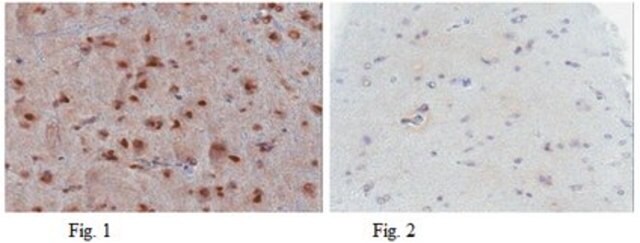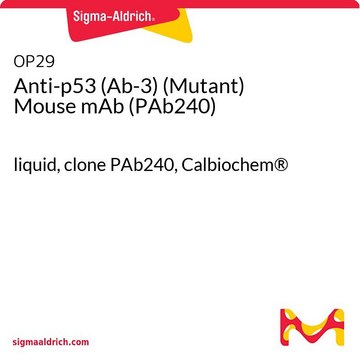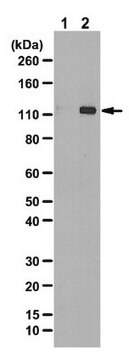CBL404
Anti-p53 Antibody, aa 211-220, clone240
clone PAb240, Chemicon®, from mouse
Sinónimos:
Anti-p53 antibody
About This Item
Productos recomendados
origen biológico
mouse
Nivel de calidad
forma del anticuerpo
purified antibody
tipo de anticuerpo
primary antibodies
clon
PAb240, monoclonal
reactividad de especies
hamster, monkey, mouse, chicken, human, rat, bovine
fabricante / nombre comercial
Chemicon®
técnicas
immunohistochemistry: suitable
immunoprecipitation (IP): suitable
western blot: suitable
isotipo
IgG1
idoneidad
not suitable for immunohistochemistry (Paraffin)
Nº de acceso NCBI
Nº de acceso UniProt
Condiciones de envío
wet ice
Información sobre el gen
human ... TP53(7157)
Descripción general
a) Most of them are missense point mutations giving rise to an altered protein function.
b) Many -but not all- mutant p53 proteins exhibit a common mutant structure, which can be recognized by monoclonal antibodies specific for p53 in the mutant conformation.
Especificidad
Inmunógeno
Aplicación
Detection of mutant p53
Prevalence of detection using CBL 404
-50% colon carcinoma sections positive (30 samples)
-70% lung carcinoma sections positive (50 samples)
-30% carcinoma breast samples positive (50 samples)
Normal and pre-malignant tissues negative
Reacts on methacarn fixed tissue
Optimal working dilutions must be determined by the end user.
Epigenetics & Nuclear Function
Transcription Factors
Ligadura / enlace
Forma física
Almacenamiento y estabilidad
Información legal
Cláusula de descargo de responsabilidad
¿No encuentra el producto adecuado?
Pruebe nuestro Herramienta de selección de productos.
Opcional
Código de clase de almacenamiento
12 - Non Combustible Liquids
Clase de riesgo para el agua (WGK)
WGK 1
Punto de inflamabilidad (°F)
Not applicable
Punto de inflamabilidad (°C)
Not applicable
Certificados de análisis (COA)
Busque Certificados de análisis (COA) introduciendo el número de lote del producto. Los números de lote se encuentran en la etiqueta del producto después de las palabras «Lot» o «Batch»
¿Ya tiene este producto?
Encuentre la documentación para los productos que ha comprado recientemente en la Biblioteca de documentos.
Nuestro equipo de científicos tiene experiencia en todas las áreas de investigación: Ciencias de la vida, Ciencia de los materiales, Síntesis química, Cromatografía, Analítica y muchas otras.
Póngase en contacto con el Servicio técnico








